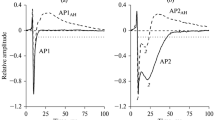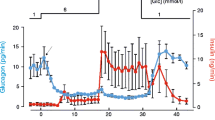Summary
It is shown that during contracture of isolated rat ventricular myocytes the high-affinity sulphonylurea drug glibenclamide fails to inhibit the opening of ATP-sensitive K channels.
Similar content being viewed by others
References
Noma A. ATP-regulated K+ channels in cardiac muscle.Nature 1983;305:147–148.
Sturgess NC, Ashford MLJ, Cook DL, Hales CN. The sulphonylurea receptor may be an ATP-sensitive potassium channel.Lancet 1985;8453:474–475.
Fosset M, De Weille JR, Green RD, et al. Antidiabetic sulfonylureas control action potential properties in heart cells via high-affinity receptors that are linked to ATP-dependent K+ channels.J Biol Chem 1988;263:7933–7936.
Trube G, Hescheler J. Inward-rectifying channels in isolated patches of the heart cell membrane: ATP-dependence and comparison with cell-attached patches.Pflügers Arch 1984;401:178–184.
Lederer WJ, Nichols CG, Smith GL. The mechanism of early contractile failure of isolated rat ventricular myocytes subjected to complete metabolic inhibition.J Physiol (Lond) 1989;413:329–349.
Findlay I, Deroubaix E, Guiraudou P, Coraboeuf E. Effects of activation of ATP-sensitive K+ channels in mammalian ventricular myocytes.Am J Physiol 1989;257:H1551-H1559.
Kantor PF, Coetzee WA, Carmeliet EE, et al. Reduction of ischemic K+ loss and arrhythmias in rat hearts. Effect of glibenclamide, a sulfonylurea.Circ Res 1990;66:478–485.
Wilde AAM, Escande D, Schumacher CA, et al. Potassium accumulation in the globally ischemic mammalian heart. A role for the ATP-sensitive potassium channel.Circ Res 1990;67:835–843.
Cole WC, McPherson CD, Sontag D. ATP-regulated K+ channels protect the myocardium against ischemia/reperfusion damage.Circ Res 1991;69:571–581.
Kleber AG. Extracellular potassium accumulation in acute myocardial ischemia.J Mol Cell Cardiol 1984;16:389–394.
Zunkler BJ, Trube G, Panten J. How do sulfonylureas approach their receptor in the B-cell plasma membrane?Naunyn-Schmiedebergs Arch Pharmacol 1989;340:328–332.
Findlay I. Inhibition of ATP-sensitive K+ channels in cardiac muscle by the sulphonylurea drug glibenclamide.J Pharmacol Exp Ther 1992;261:540–545.
Findlay I. Effects of pH upon the inhibition by sulphonylurea drugs of ATP-sensitive K+ channels in cardiac muscle.J Pharmacol Exp Ther 1992;262:71–79.
French JF, Riera LC, Mullins UL, Sarmiento JG. Modulation of [H3]glibenclamide binding to cardiac and insulinoma membranes.Eur J Pharmacol 1991;207:23–28.
Venkatesh N, Lamp ST, Weiss JN. Sulfonylureas, ATP-sensitive K+ channels and cellular K+ loss during hypoxia, ischemia and metabolic inhibition in mammalian ventricle.Circ Res 1991;69:623–637.
Ashford MLJ, Boben PR, Treherne JM. Tolbutamide excites rat glucoreceptive ventro-medial hypothalamic neurones by indirect inhibition of ATP-K+ channels.Br J Pharmacol 1990;101:531–540.
Author information
Authors and Affiliations
Rights and permissions
About this article
Cite this article
Findlay, I. Effects of glibenclamide upon ATP-sensitive K channels during metabolic inhibition of isolated rat cardiac myocytes. Cardiovasc Drug Ther 7 (Suppl 3), 495–497 (1993). https://doi.org/10.1007/BF00877613
Received:
Accepted:
Issue Date:
DOI: https://doi.org/10.1007/BF00877613




